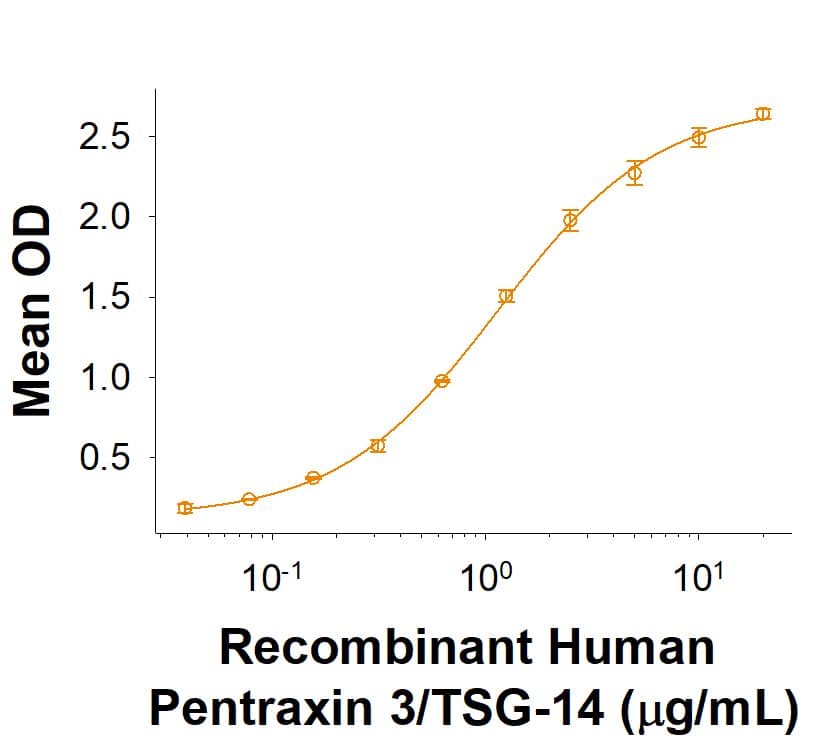Recombinant Human Pentraxin 3/TSG-14 His-tag Protein, CF
R&D Systems, part of Bio-Techne | Catalog # 10292-TS

Key Product Details
Source
CHO
Accession #
Structure / Form
Multimer consisting of as many as ten non-covalently and covalently linked subunits.
Conjugate
Unconjugated
Applications
Bioactivity
Product Specifications
Source
Chinese Hamster Ovary cell line, CHO-derived human Pentraxin 3/TSG-14 protein
Glu18-Ser381, with a C-terminal 6-His tag
Glu18-Ser381, with a C-terminal 6-His tag
Purity
>95%, by SDS-PAGE visualized with Silver Staining and quantitative densitometry by Coomassie® Blue Staining.
Endotoxin Level
<0.10 EU per 1 μg of the protein by the LAL method.
N-terminal Sequence Analysis
Glu18
Predicted Molecular Mass
41 kDa
SDS-PAGE
38-55 kDa, under reducing conditions
Activity
Measured by its binding ability in a functional ELISA.
When Human C1q is immobilized at 5 µg/mL (100 µL/well), Recombinant Human Pentraxin 3/TSF-14 His-tag (Catalog # 10292-TS) binds with an ED50 of 0.5-4 μg/mL.
When Human C1q is immobilized at 5 µg/mL (100 µL/well), Recombinant Human Pentraxin 3/TSF-14 His-tag (Catalog # 10292-TS) binds with an ED50 of 0.5-4 μg/mL.
Scientific Data Images for Recombinant Human Pentraxin 3/TSG-14 His-tag Protein, CF
Recombinant Human Pentraxin 3/TSG-14 His-tag Protein Binding Activity
When Human C1q is immobilized at 5 μg/mL (100 μL/well), Recombinant Human Pentraxin 3/TSG-14 His-tag (Catalog # 10292-TS) binds with an ED50 of 0.5-4 μg/mL.Recombinant Human Pentraxin 3/TSG-14 His-tag Protein SDS-PAGE
2 μg/lane of Recombinant Human Pentraxin 3/TSG-14 His-tag (Catalog # 10292-TS) was resolved with SDS-PAGE under reducing (R) and non-reducing (NR) conditions and visualized by Coomassie® Blue staining, showing bands at 38-55 kDa under reducing condition.Formulation, Preparation and Storage
10292-TS
| Formulation | Lyophilized from a 0.2 μm filtered solution in PBS with Trehalose. |
| Reconstitution | Reconstitute at 500 μg/mL in PBS. |
| Shipping | The product is shipped at ambient temperature. Upon receipt, store it immediately at the temperature recommended below. |
| Stability & Storage | Use a manual defrost freezer and avoid repeated freeze-thaw cycles.
|
Background: Pentraxin 3/TSG-14
References
- Lee, T.H. et al. (1990) Mol. Cell. Biol. 10:1982.
- Breviario, F. et al. (1992) J. Biol. Chem. 267:22190.
- Lee, G.W. et al. (1993) J. Immunol. 150:1804.
- Osmand, A.P. et al. (1977) Proc. Natl. Acad. Sci. USA 74:739.
- Goodman A.R. et al. (1996) Cytokine & Growth Factor Reviews 7:191.
- Bottazzi, B. et al. (1997) J. Biol. Chem. 272:32817.
- Introna, M. et al. (1996) Blood 87:1862.
- Altmeyer, A. et al. (1995) J. Biol. Chem. 270:25584.
- Luchetti, M.M. et al. (2000) Clin. Exp. Immunol. 119:196.
- Rovere, P. et al. (2000) Blood 96:4300.
- Dias, A.A.M. et al. (2001) J. Leukocyte Biol. 69:928.
- Rolph, M.S. et al. (2002) Arterioscler. Throm. Vasc. Biol. 22:e10-4.
Long Name
Tumor Necrosis Factor Stimulated Gene 14
Alternate Names
PTX3, TSG-14, TSG14
Gene Symbol
PTX3
UniProt
Additional Pentraxin 3/TSG-14 Products
Product Documents for Recombinant Human Pentraxin 3/TSG-14 His-tag Protein, CF
Product Specific Notices for Recombinant Human Pentraxin 3/TSG-14 His-tag Protein, CF
For research use only
